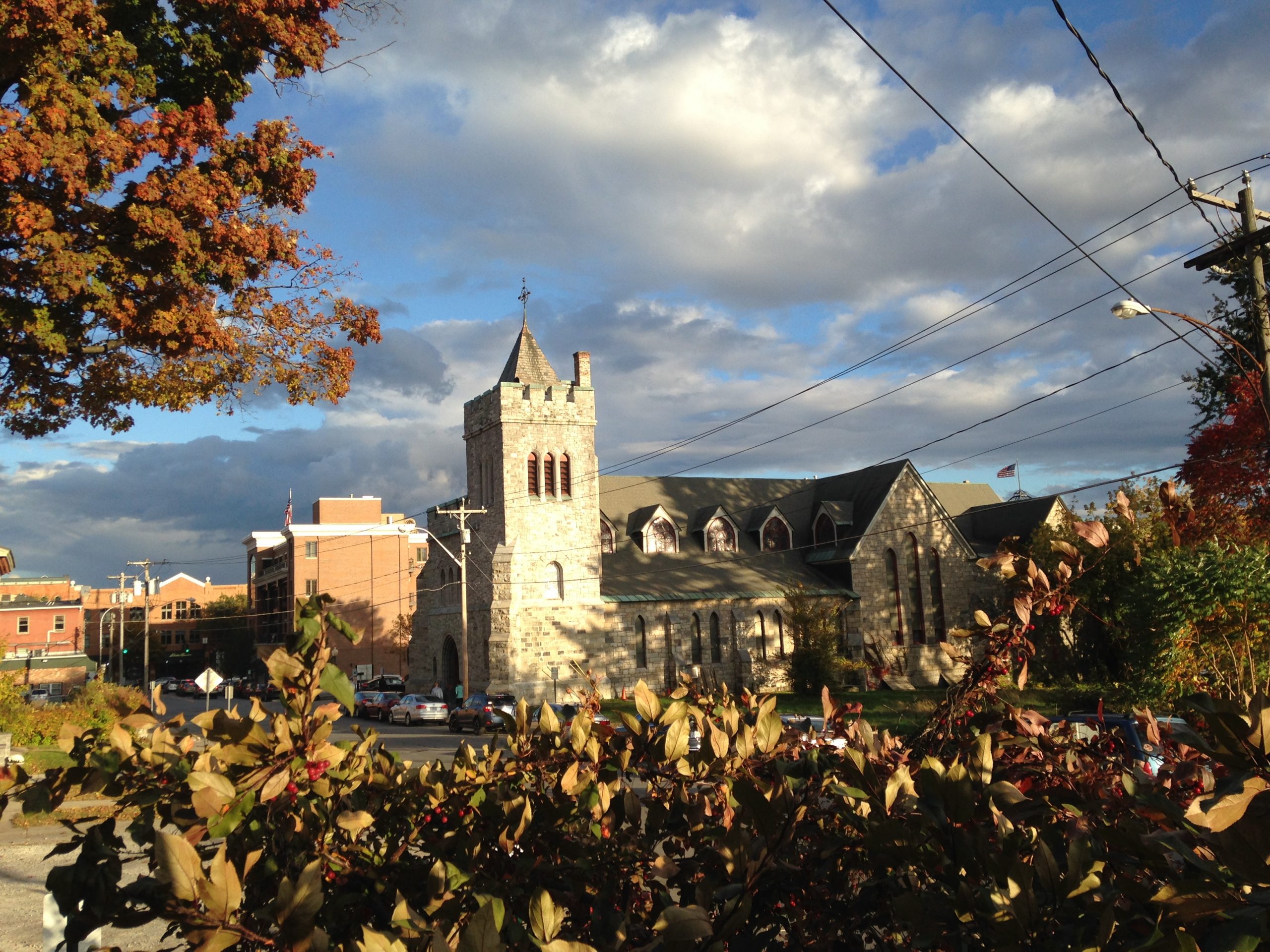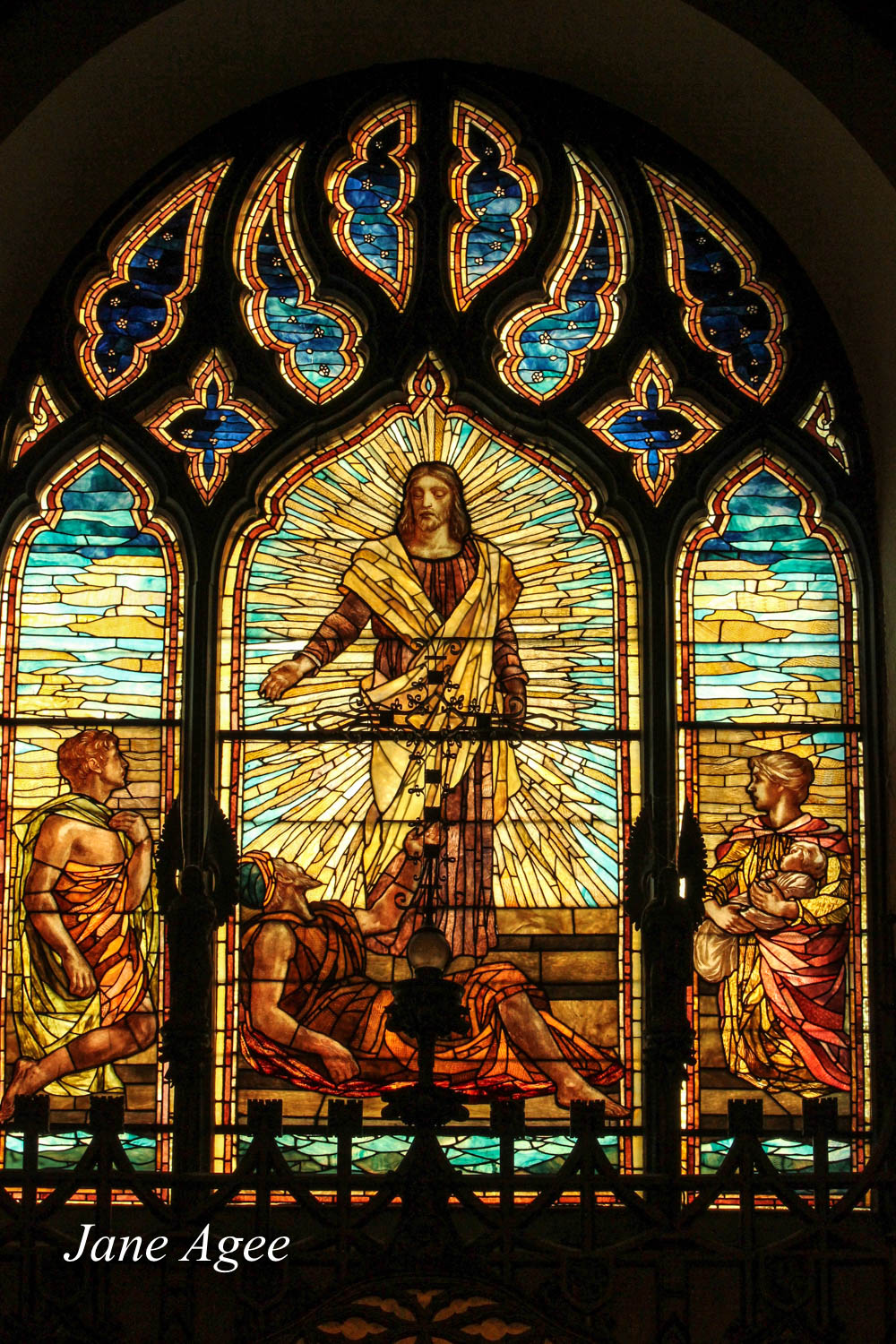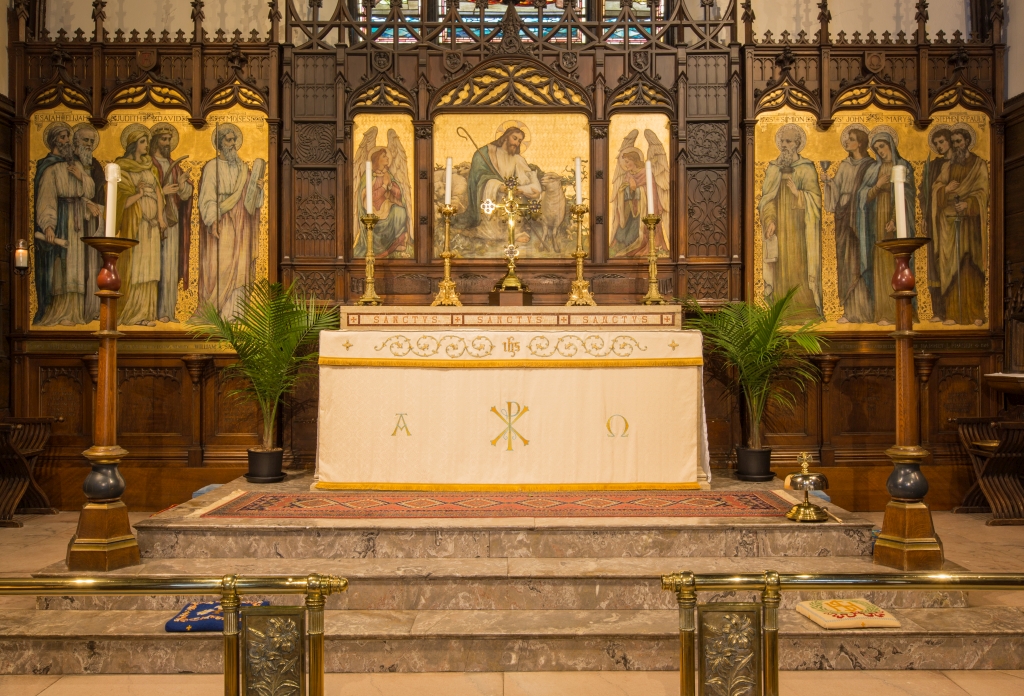The Church Building
As you can see in the history of the church building detailed below, Bethesda is an old church, at least by American standards, and it has the character and charm you would expect. So we encourage you to come! But, of course, old buildings need lots of love and care to stay upright. Fortunately, due to the generous support of many parishioners, for the last several years, and continuing to the present day, Bethesda has tackled many long-deferred projects. Our aim is to be good stewards of our portion, so that we may contribute to the stability and beauty of the building for the benefit of generations yet to come.
Below, you are taken through two time lines: one tells the story of our inheritance, the other how we’re making our mark.
Restoration Progress
Existing Conditions Report
As part of Bethesda’s capital projects plan, an extensive restoration of the church building is anticipated. In 2015, the parish received a study grant from the New York Landmarks Conservancy toward the cost of a study of existing conditions by our expert architectural team at John G. Waite Associates, Architects, of Albany, New York. The results of that study, the Existing Conditions Report, detail many measures the parish should take to keep our historic building in good condition, and to make a number of lasting improvements. Individuals have asked if financial assistance may be directed toward the building restoration. Inquiries may be made to the parish office.
The items below show the progress made on the Existing Conditions Report since 2015.
Church Windows
In 2017, six windows facing Washington Street (including our signed Tiffany angels in the upper gallery) were secured with protective glazing and ventilation to prevent corrosion. The work was performed by experts from J & R Lamb Studios, with funds provided by the proceeds of Bethesda’s annual August Building Fund event.
In 2018-19, one more window was restored, this one on the east side of the building, near the transept. The window was removed from its opening, taken to New Jersey and re-leaded by Lamb’s craftsmen. Upon return in Spring 2019, a new wooden molding was installed, because the old one had rotted. Again, protective glazing and ventilation were installed, and this valuable asset was secured for decades to come. Funding was provided by proceeds from Bethesda’s annual August Building Fund event.
High Altar Reredos
In 2019, Bethesda’s High Altar Reredos depicting Jesus the Good Shepherd, as well as Saints of both Old and New Testaments, was cleaned and restored to its original vibrancy. Artists deployed through Lamb Studios meticulously cleaned the work, in-fill painting was done, and protective compound applied that will make this priceless work more visually present for many years to come. Artistic contractor was Mr. Valentine Michalski, an accomplished art conservationist. The generosity of Stephen and Joan Hyman made this priority a reality.
Front Door
In 2018, the parish’s August Building Fund event was dedicated to make needed repairs and changes to the front doors of the church. Center interior doors were replaced with a glass door in order to provide a vision of our interior to passersby, and perhaps a silent invitation to enter for meditation, inquiry or participation. The front door project was completed in summer 2020 and has resulted in an entry that is respectful of the building’s historic character, as well as of building codes, common sense and overall cost.
Mechanical Equipment
In late 2021, Bethesda installed a brand new, state-of-the-art natural gas boiler to replace the old one which had become over-stressed. In the same year, a leaky sprinkler valve was replaced to ensure the sprinkler system is reliable and passes fire inspection. And continuing into 2022, we are in the process of replacing a grinder pump from the 1950s so that the plumbing below street level will work properly. By clicking the button below, you can read the report (and see photos) regarding these projects which was given by the property management committee at the parish’s annual meeting in January 2022.
Roof Replacement
In 2022, Bethesda is undertaking a rather large project — replacing the roof of its historic church building. As this is ongoing, there will be updates in latest news when warranted. See this item in latest news posted in February 2022 which explains the process to be undertaken. Also, by clicking the button below, you can read the report (and see photos) regarding this project which was given by the property management committee at the parish’s annual meeting in January 2022.
The History of the Building

Beginnings
Bethesda Episcopal Church was incorporated in October, 1830. Services were initially conducted in a refitted spring house donated by John Clarke, one of the first vestrymen. This chapel was at the intersection of Putnam and Congress Streets in what is now Congress Park. In the decade that followed, the crush of summer visitors gave some urgency to finding a larger building. After some controversy about where a new church should be built, the vestry decided to purchase a lot from Rockwell Putnam on Washington Street for the large sum of $3,569.
The main body of the church was begun in 1841-42 and first used for divine services in 1844. On Wednesday, October 17, 1866, Bethesda Church, being free of debt, was consecrated by the Rt. Rev. Horatio Potter, D.D., Bishop of New York. A set of plans for the building were drawn by Mr. J. Richard Upjohn, a famous New York architect. One of his most famous churches is Trinity Church in New York. Although there are letters between Upjohn and the vestry indicating that he did submit plans after making several visits to Saratoga Springs to meet with the vestrymen, Upjohn was not paid for his plans, much to his distress, and the vestryman corresponding with him claimed to have found another architect. However, there is much evidence that Upjohn’s plans were used. One of the characteristics of his churches is the use of items in three parts representing the Trinity. This characteristic can be seen in the three doors leading into the nave, the openings at the front of the nave, and the three narrow stained glass windows on each of the four walls of the church. Now only the transept windows remain.
The interior of Bethesda shows the influence of the Gothic revival that had such an important role in the architecture of the Victorian period. Beginning with the ceiling, the pointed wooden arches gave the name “Gothic” to this style. Note the heavy use of carved wood, so loved by Victorian builders. These arches are called working arches by architects, that is to say, they actually perform the function of holding up the roof and are not there for decoration.
1858-1861 Renovations
During the rectorship of The Rev. Robert C. Rogers, the building had its first major change. Originally the nave of Bethesda was much smaller than it is today. Thanks to skillful blending, this is lost to the eye today. There were no side aisles or pews. The nave was in the shape of a cross. The outer walls, between the tower and the transepts, were moved out on a line with the outer walls of the transepts. This gives the church a more rectangular shape today.
One of the glories of Bethesda is its windows. The windows on the second story are clear in the style of Victorian bottle glass. This style of glass work took its name from the round bottom of hand blown glass.
The stained glass windows on the sides and rear have a mixture of Old and New Testament symbols. The Star of David, a beautiful chalice, the all-seeing eye (found on the back of our dollar bill), the pelican biting itself to feed its young by shedding its blood, and the Tablets of the Commandments, with the New Testament, can be found depicted among them.
The three large windows on the eastern transept are called the Resurrection windows, as the center one shows Christ coming out of the tomb, recalling one of the basic beliefs of Christianity. In style the figures are almost Byzantine or Eastern Orthodox. The figures and faces are elongated, and there is little attempt at realism. The heavy bearded, youthful Christ, with deep spiritual eyes, was a favorite style of the Eastern Church and may be seen in many icons of him.
The windows of the west transept are very different from the east and are called the Ascension windows, due to the scene in the center window. At the top of this window is the word for God in Hebrew. The letters YAWH are pronounced “Yahweh,”we think. Only the High Priest knew the actual pronunciation. God’s name was not to be spoken, so only the consonants were recorded.

Chancel window: “Christ, the Miracle at the Pool of Bethesda”, c. 1887, design by Francis Lathrop, stained glass by J & R Lamb Studios; photo by Jane Agee.
Above the High Altar is a large stained glass window given by Mr. and Mrs. Spencer Trask in 1887. Bethesda was named for a healing miracle depicted in the window and recorded in the Gospel of John in the fifth chapter, verses 1-9, which takes place by the pools of Bethesda. In the 19th century, Saratoga Springs was world famous for its healing springs and water, and Bethesda is an appropriate name.
In the back of the church, above the choir pews in the balcony, there are three of the most valuable of our stained glass windows. They were done by Tiffany of New York. All the windows are specially protected on the outside from weather and vandalism. It was only after the destruction of the Grand Union Hotel in 1953 that these windows could reveal their brilliant colors, particularly the dark blues and reds. Bethesda was surrounded on three sides by the towering hotel and other buildings so these windows did not receive direct sunlight.
The balcony affords a splendid view of the church. The organ which is now in the balcony was built by Daniel Lemieux and Associates of Argyle, New York, and dedicated in 2009. It was donated by the Pierce children to the glory of God in memory of their parents, George and Laura Pierce. This particular style of organ was common in the early 1900s and is similar to the antiphonal division that was in this space in 1920. Its two manuals, pedal board, 40 stops and 520 vintage pipes are controlled with an action that is electro-pneumatic in nature. It’s been updated with a state of the art digital switching system and also has the capability of playing itself, as well as from the front console. This organ, in addition, needs its own electric blower which produces a much higher wind pressure, also common in that period.
1880’s Renovations
Around 1887, there was a major renovation of the church which changed the exterior and interior of Bethesda a great deal. In 1887, the narthex, bell tower, and bells were added, in memory of Rockwell Putnam and children, by Elizabeth Haight Putnam, Rockwell Putnam’s wife. Also, along with the stained glass window above the altar, mentioned earlier, the baptismal font, given in memory of Samuel A. Willoughby by his son, Hugh, came at this time. Its heavy use of marble and with the carved wood, its Victorian Gothic origin is revealed. The eight columns holding up the basin symbolize the eight days elapsing between the birth of Jesus and his circumcision, when he was formerly named and presented at the Temple. Around the side of the Font, are many of the earliest and most common Christian symbols: the Dove; the three Fish interlocked in a triangle; the Lamb of God; and IHS, meaning Jesus. The Mass Ewer, used for bringing water to the Font, may be one of the oldest articles in the building, dating from the 1860s. The Font was originally where the Side Altar is today. For those who know Saratoga’s history, the Altar Cross, on the Side Altar, was given in memory of Madame Jumel, a rather famous and notorious summer resident of Saratoga at the turn of the nineteenth century.
The High Altar area was extensively changed in the 1880s, although the lectern and pulpit were a part of the original building. The heavy wrought iron Rood Screen (named for the cross on top) was added. It separates the congregation from the High Altar or sanctuary area, where the most solemn consecration of the elements for communion takes place. On the floor is a mosaic cross, done in Eastern Orthodox style and is made of hundreds of little pieces of marble. Here also is a plaque given in memory of The Rev. Irving G. Rouillard, who served Bethesda for thirty-two years as rector, 1918-1950. On either side are the pews for the Daniel Jones, Griffith Memorial Choir, the Adult Choir of the Schola Cantorum on the left, and the children of the Treble Choir on the right. The organ in the Sanctuary was built by Casavant Freres of Montreal, Canada in 1967. This, German Baroque three manual, organ consists of 38 stops and 50 ranks, which is equivalent to approximately 3000 pipes.
The High Altar itself is made of three types of marble and is extremely heavy. In fact, in the basement there are extensive underpinnings just to keep the Altar from falling through the floor. On the front of the Altar you can see more mosaic work and the Greek A (Alpha) and Omega which remind us of Christ, the beginning and the end of all in life. In our alphabet we would say the A and the Z. In the center is the symbol of Christ, IHS, with the wreath of eternity around it.
To the right of the Altar is the sedillia, that is, a chair for the celebrant and serving acolytes. To the left is a Victorian Gothic chair, called the Bishop’s Chair. It is used by the Bishop of the Albany Diocese on his visits and is a symbol of the Apostolic and Episcopal nature of the Anglican Church. Also to the left, the light, which is always burning, hangs in front of the Aumbry, where the consecrated bread and wine are kept for devotional use, regular emergency administration to the shut-ins and for the sick and dying.
Behind the High Altar stand the representations of some of the saints of the Bible and a dove, in a pre-Raphaelite style. Between them there is a glass orb representing the world, topped by the Cross of Christ, which signifies Christ conquering the world. High in the ceiling is a star of lights which is only lighted at Midnight Mass on Christmas Eve, signifying the star which led the Wise Men to the Christ Child in Bethlehem.
On the left nave wall are two memorable plaques. One is to The Rev. Dr. Joseph Carey, who served as Rector of Bethesda from 1873-1913, and the other is to The Rev. William Croswell Doane, who was the great First Bishop of Albany (1869-1913). These two men were close friends in their long stewardship together. In the spring of 1913, Bishop Doane came to Bethesda for what would be his last visitation. Both he and Dr. Carey were very advanced in years and feeble. After the service the Bishop said, “My dear Carey, you and I have not long for this world but, we shall soon meet the great beyond.” About two weeks later the Bishop died and Dr. Carey followed three weeks after that. To the memory of these two men and in honor of their great work, Bethesda placed these two plaques side by side.
The last major structural change came in 1898 when the marble columns were added. One of them is dedicated to Gabriel Duval Clark, Sr., and other to Mrs. Harriet Perry.
The outside front of Bethesda is an adaptation of the Norman Romanesque style. The style is named after the Norman conquerors of England in 1066 A.D. It was a rough and warring time and the style of the church reflects that. With its grey stone walls, narrow windows, and almost castle-like keep front, it looks formidable. The different colors of the stone and the different sizes show the various renovations of the church through the years. However, it is a style used by Anglican Churches throughout the world, and one suspects many visitors would know this was an Episcopal Church before they saw the sign.
Bethesda Today
The newest entrance was added in 1995. The addition of the disabled access, with a built in lift, was kept in the same historical structure, providing protection from the elements and access for the disabled.
For all its historic significance and beauty, Bethesda is not primarily a museum but rather a place where the “Honor of the Lord” dwells. This is a place dedicated to the living God for the people who live in Him.
When one thinks of the number of baptisms, confirmations, weddings, funerals, weekday and Sunday services that have taken place here, the true monument of more than 150 years clearly is not so much a building but the people who prayed and pleaded, gave thanks and were fed, rejoiced and sang to the Lord here, in their own time. At least six wars, numerous recessions and depressions, and imagine how much inflation, have taken place since the first service was held here. And yet God’s message of hope for the sick, help for the downcast, happiness in adversity and life for the dead remains the best “good news” the people of today can hear.
The people of Bethesda are dedicated to presenting that same gospel of comfort and good news in our time as were those who laid the first stone in this beautiful building in 1841.


